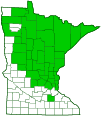leatherleaf
(Chamaedaphne calyculata)
Conservation • Wetland • Description • Habitat • Ecology • Use • Distribution • Taxonomy
Description |
||
Leatherleaf is common and abundant shrub of northern wetlands. It occurs throughout northern Europe and Asia and northern North America. In the United States it occurs from Maine to Minnesota, south to New Jersey and Illinois, with disjunct populations in North Carolina and Washington State. In Minnesota it occurs in the north-central and northeast regions south to the Metro region. It is found in open areas in bogs, marshes, swamps, and floodplains, and on riverbanks and lakeshores. It grows under full sun in acidic, nutrient-poor soils. It is the dominant shrub of dwarf shrub wetland communities. Leatherleaf is a perennial, evergreen, dwarf shrub that rises on several stems from an underground horizontal stem (rhizome). It can be 8″ to 60″ tall but is usually no more than 40″ in height. It often forms dense thickets. The stems may be erect, curving up from the base (ascending), or nearly horizontal (spreading). They have many stiff, wiry branches. First year twigs are brown and are covered with minute hairs and scattered scales. In the second year they turn gray and eventually brown or purplish-brown. The mass of spongy cells in the center of the stem (pith), best seen when the stem is sliced at an angle, is solid. The leaves are alternate, leathery, evergreen, ⅝″ to 2″ (15 to 50 mm) long, and ⅜″ to ⅝″ (10 to 15 mm) wide. They are on short, 1⁄16″ to ⅛″ (1.5 to 3 mm) long leaf stalks (petioles). They often point upward from the stem. The largest mature leaves are 3 times as long as wide. The leaf blades are oval, sometimes with nearly parallel sides (oblong), sometimes widest in the middle and narrowing to both ends (elliptic), rarely widest beyond the middle (obovate). They are wedge shaped at the base, taper to a broad or narrow point at the tip, and have a short, abrupt point at the tip (mucronate). The upper surface is dark olive-green, dull, and hairless, and is sparsely covered with scales. The lower surface is pale green and densely covered with white or rust-colored scales. The margins are slightly rolled under and have minute, rounded teeth. The inflorescence is a leafy, 1½″ to 4¾″ (4 to 12 cm) long, unbranched, one-sided (secund) cluster (raceme) of 8 to 20 small flowers at the end of the stem and branches. The leaves within the raceme are similar to branch leaves but much smaller. The flowers are urn-shaped and 3⁄16″ to ¼″ (5 to 7 mm) long. They have both male and female parts (bisexual). Each flower hangs downward singly from a leaf axil on a 1⁄32″ to ⅛″ (1 to 3 mm) long, densely hairy stalk (pedicel). There are 5 outer floral leaves (sepals), 5 petals, 10 stamens, and 1 style. The sepals are broadly triangular, 1⁄16″to ⅛″ (1.5 to 3 mm) long, and scaly. The petals are fused for most of their length then separated into 5 short lobes. The lobes are 1⁄32″ to 1⁄16″ (1 to 2 mm) long and curved backward. The stamens do not extend beyond the corolla. The style sometimes extends slightly beyond the corolla. The fruit is a hairless, flattened globular, 5-chambered, ⅛″ to 3 ⁄16″ (3 to 5 mm) in diameter capsule. It matures in the fall and remains on the plant through the winter. The sepals and the style persist with the capsule. |
||
Height |
||
8″ to 60″ |
||
Flower Color |
||
White |
||
Similar Species |
||
Habitat |
||
Wet. Bogs, marshes, swamps, floodplains, riverbanks, and lakeshores. Full sun. |
||
Ecology |
||
Flowering |
||
Early May to mid-June |
||
Pests and Diseases |
||
|
||
Use |
||
|
||
Distribution |
||||
|
Sources |
|||
| 5/6/2023 | ||||
Nativity |
||||
Native |
||||
Occurrence |
||||
Common and abundant in the northeastern third of Minnesota. |
||||
Taxonomy |
|||
| Kingdom | Plantae (Plants) | ||
| Subkingdom | Pteridobiotina | ||
| Phylum | Tracheophyta (Vascular Plants) | ||
| Class | Magnoliopsida (Dicots) | ||
Order |
Ericales (heathers, balsams, primroses, and allies) | ||
Family |
Ericaceae (heath) | ||
| Subfamily | Vaccinioideae (blueberries, cranberries, huckleberries, and allies) | ||
| Tribe | Gaultherieae | ||
Genus |
Chamaedaphne (leatherleaves) | ||
Leatherleaf is the only species in the genus Chamaedaphne. |
|||
Subordinate Taxa |
|||
Synonyms |
|||
Andromeda calyculata Cassandra calyculata Cassandra calyculata var. angustifolia Cassandra calyculata var. latifolia Chamaedaphne calyculata var. angustifolia Chamaedaphne calyculata var. latifolia Chamaedaphne calyculata var. nana |
|||
Common Names |
|||
cassandra leatherleaf |
|||
Glossary
Ascending
Growing upward at an angle or curving upward from the base.
Corolla
A collective name for all of the petals of a flower.
Elliptic
Narrowly oval, broadest at the middle, narrower at both ends, with the ends being equal.
Mucronate
Tipped with a short, sharp, abrupt point.
Oblong
Two to four times longer than wide with nearly parallel sides.
Obovate
Inversely egg-shaped, with the attachment at the narrower end.
Pedicel
On plants: the stalk of a single flower in a cluster of flowers. On insects: the second segment of the antennae. On Hymenoptera and Araneae: the narrow stalk connecting the thorax to the abdomen: the preferred term is petiole.
Petiole
On plants: The stalk of a leaf blade or a compound leaf that attaches it to the stem. On ants and wasps: The constricted first one or two segments of the rear part of the body.
Pith
The spongy cells in the center of the stem.
Raceme
An unbranched, elongated inflorescence with stalked flowers. The flowers mature from the bottom up.
Sepal
An outer floral leaf, usually green but sometimes colored, at the base of a flower.
Spreading
Extending nearly horizontal.
Visitor Photos |
|||||
Share your photo of this plant. |
|||||
| This button not working for you? Simply email us at info@MinnesotaSeasons.com. Attach one or more photos and, if you like, a caption. |
|||||
Luciearl |
|||||
Located in bog/wetland |
|||||
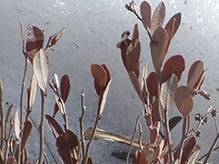 |
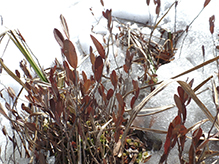 |
||||
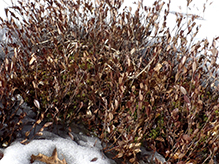 |
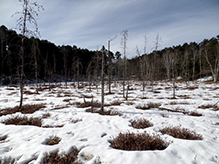 |
||||
MinnesotaSeasons.com Photos |
|||||
|
|||||

Slideshows |
||

Visitor Videos |
|||
Share your video of this plant. |
|||
| This button not working for you? Simply email us at info@MinnesotaSeasons.com. Attach a video, a YouTube link, or a cloud storage link. |
|||
Other Videos |
|||
| chamaedaphne calyculata Flowers |
|||
About
Aug 22, 2011 chamaedaphne calyculata |
|||
| Leatherleaf (Chamaedaphne calyculata) in full bloom at Glacial Park DiscoverMCCD |
|||
About
Apr 22, 2020 Leatherleaf (Chamaedaphne calyculata) is in full bloom! This plant can be found in bogs, like the one in Glacial Park, and when in full bloom the bog takes on a cream hue. This is a state-threatened species and happens to be a dominant one in our bogs. |
|||
| Last snow and Bog Leatherleaf flowering Mukhrino Field Station |
|||
About
Feb 5, 2018 The last snow come late in 2014 when leaves were already partly opened and the Bog Leatherleaf (C. calyculata) was flowering, on 30 May. You could see raised water lever due to snowmelt in early summer of Mukhrina river, and a piece of bog nearby the station's house. The snow was heavy and surprizing and inspired me to make a short movie :). |
|||

Created: 4/27/2020
Last Updated:
